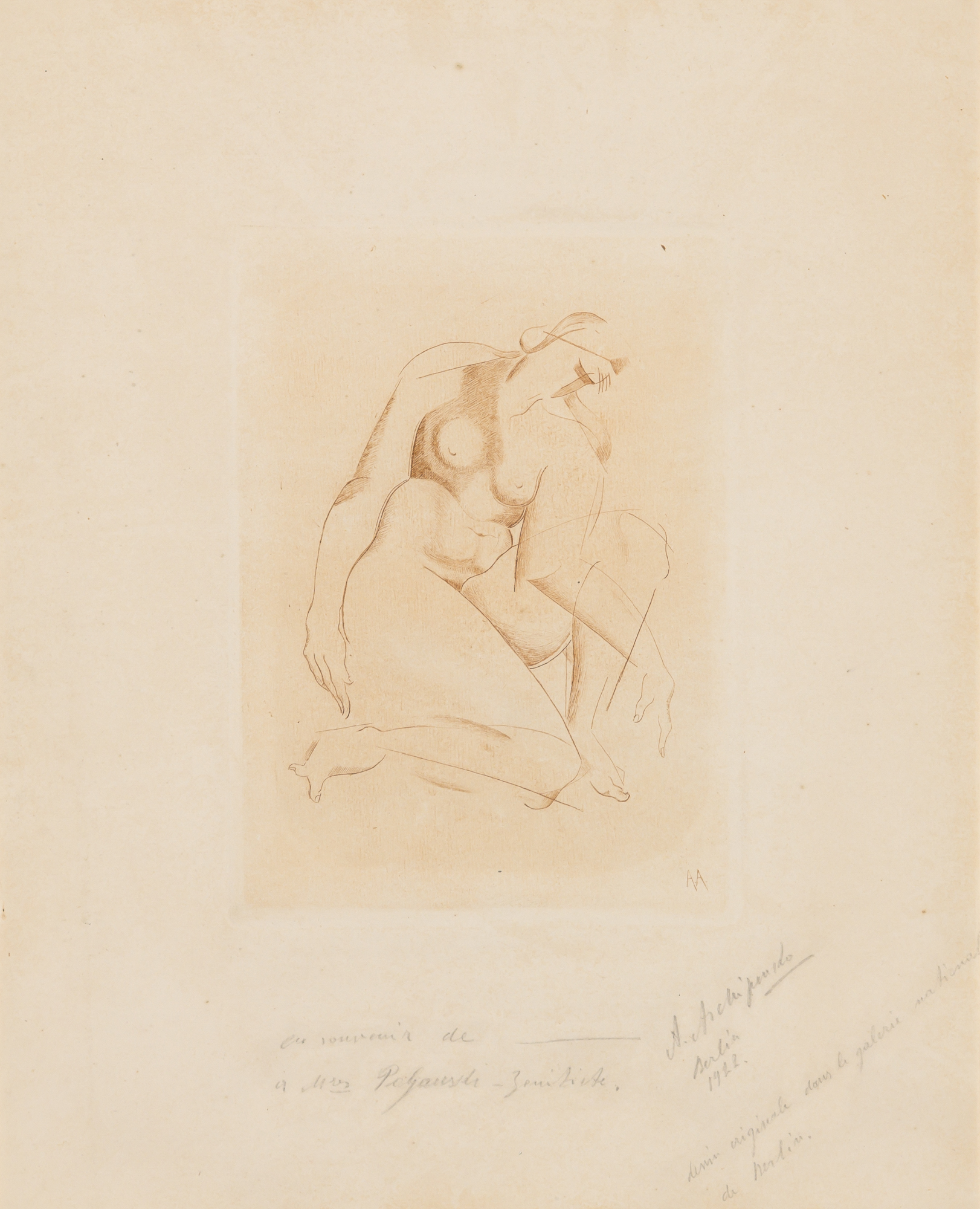
|
|
Kneeling
[└ Genoux]
Karshan 4, only
known state
drypoint engraving, circa 1920, on medium-heavy cream wove paper, a splendid
proof impression
of the only known state, printed in sanguine, with full margins, signed, situated Berlin, and dated 1922 by the artist in pencil,
with an important dedication, below left, "en souvenir de ____ / a Mnr (?) Poljanski - Zenitiste.", and annotated "dessin originale [sic] dans la galerie nationale/ de Berlin" by the artist, of
the utmost rarity, if not unique, very slight lightstaining overall,
faint matstaining and foxing, and some soiling in the margins,
otherwise in quite excellent condition,

P. 178x133mm., S. 324x257mm.
|
Firstly, it must be said that this impression is an exceedingly
rare, perhaps unique, proof, unknown to Karshan when he drafted the catalogue raisonnÚ in 1974.
As he states,
Kneeling
is the second drypoint of only three that the artist executed
["Kneeling," "Bending," "Angelica"]. The original copper plates [of
these three] were discovered by the artist's widow in 1966 at his
atelier in Woodstock, New York. These plates were in sufficiently good
condition to permit posthumous editions to be printed, since only one
life-time proof was known of "Bending," two of "Angelica," and none of
"Kneeling." These three editions were printed in New York by Miss
Judith Foster in 1967, under the supervision of the artist's estate. - in
Donald Karshan, Archipenko: The Sculpture and Graphic Art. Tubingen:
Ernst Wasmuth, 1974, page 75.
The present
impression is thus one of the few lifetime impressions that may now be
identified (we have only seen one other on auction, in 2022, printed in
black on a similar paper, and signed in pencil), though it is
impossible to say if the print was executed in Paris (as Karshan's
dating would imply), and eventually printed later, after Archipenko's
move to Berlin in 1921, as the present annotations would seem to
indicate.
It
is dedicated to Branko Ve Poljanski, a Serbo-Croatian writer and painter who
was involved (with his brother, Ljubomir Micić) in the creation of Zenit, their international magazine for art and culture*
in Zagreb, 1921-1926, and he was active in promoting the avant-garde
movement of Zenitism across Europe. Micić cogently defined it as "abstract metacosmic expressionism." (NB It is amusing to note
Archipenko's complicitous reference to Poljanski's Zenitiste affiliation in the dedication!)
Aside from their association with the Galerie Der Sturm, Poljanski (who'd moved to Berlin in 1922) indeed knew Archipenko rather well, promoting his work in Zenit regularly and often visiting the "great master" at his private academy in Berlin. **
Archipenko's annotation refers to his original
drawing in the Nationalgalerie, which the curators at our request have been able to
identify under the reference SZ Archipenko 1 (Inv. F III 278); it was acquired from the artist in 1921:
Weiblicher Akt, kniend, um 1918
Zeichnung, 49.2 x 32 cm
This drawing was however confiscated by the Nazis in 1937 as part of their Entartete Kunst
policy***, and curator in charge of prints and drawings does not know
of its whereabouts, although it had been identified in the art trade in
1957.
The museum
unfortunately does not have a photograph of the work, which leaves us
wanting as to Archipenko's preparation for the print, though the
careful draftsmanship in drypoint gives us the idea of a certain
dynamism, offset by the dramatically broken lines, formal overlays, and
the strong volumes induced by his careful stippling.
* See https://web.archive.org/web/20100612112250/http://digital.nb.rs/zenit/english.html
and
https://www.avantgarde-museum.com/en/museum/collection/authorsbranko-ve-poljanski~pe4505/
** See
https://modernistarchitecture.wordpress.com/2010/10/22/branko-ve-poljanski%E2%80%99s-%E2%80%9Cthrough-the-russian-exhibition%E2%80%9D-1923/
*** It has also be inventoried
in the Freie Universitńt's database of Degenerate Art Research Center :
https://www.geschkult.fu-berlin.de/en/e/db_entart_kunst/index.html


